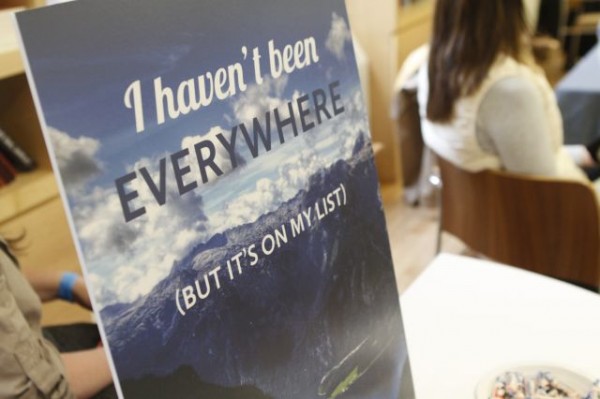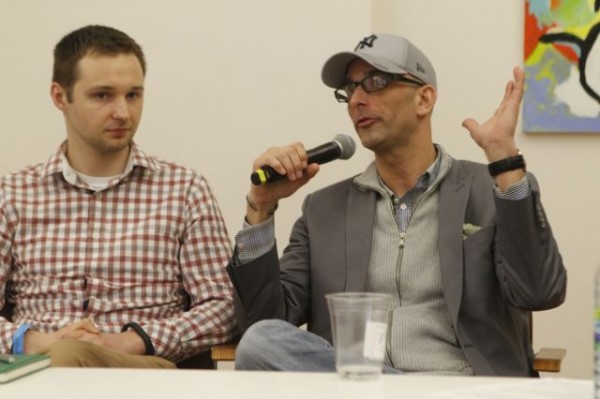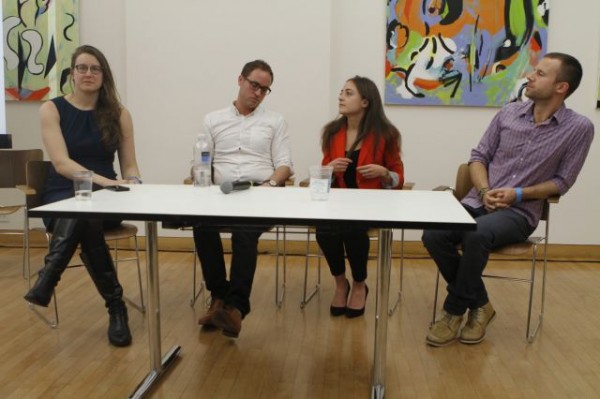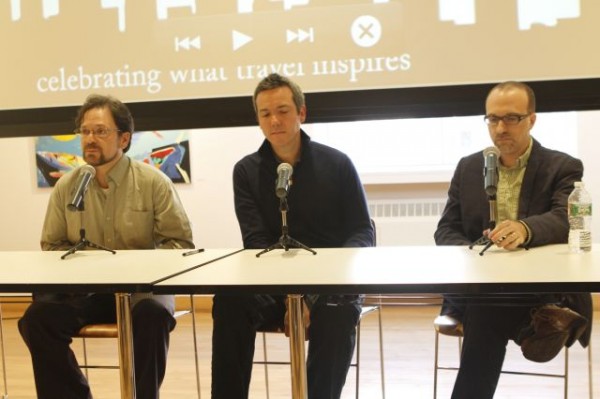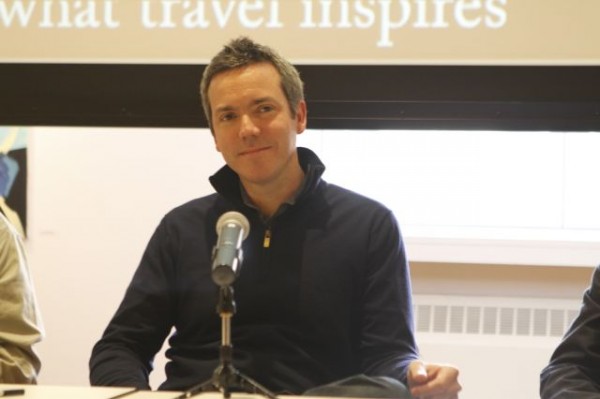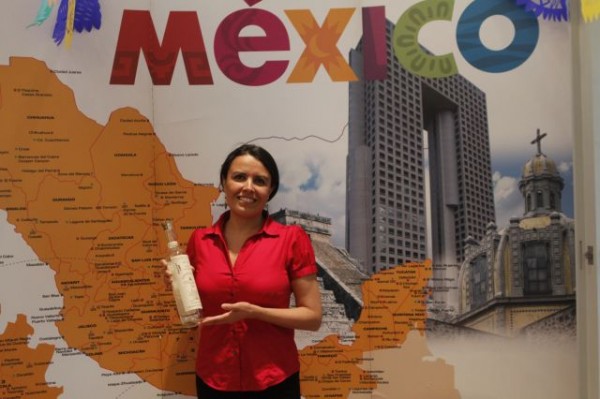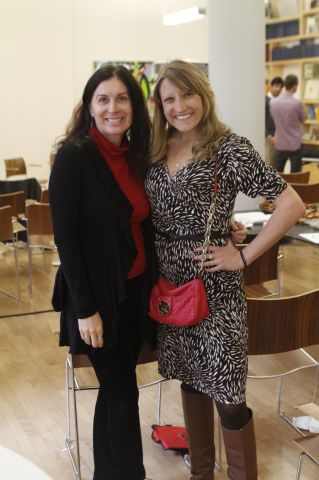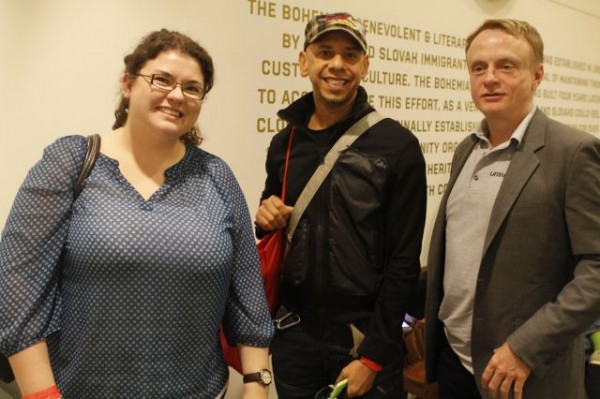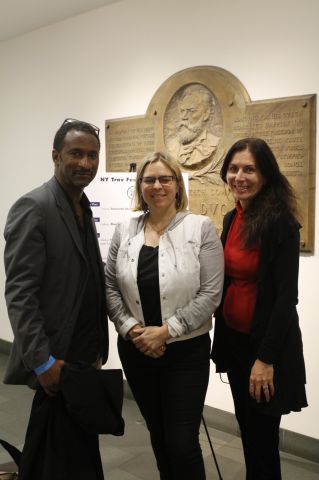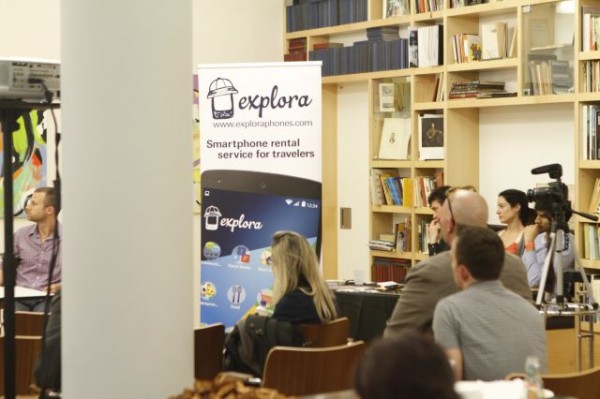Now in its second year, the New York Travel Festival which was held in New York City’s upper East Side this past weekend reached 500 attendees+, a significant spike from last year. Their goal? To reinvent the consumer travel show experience for tech-savvy, immersive travelers who see travel as a means of experience, not just escape. We were a proud media partner of this fabulous event, which was held at two venues on April 26-27, 2014 – Bohemian National Hall and Hostelling International.
There were a series of sessions on various floors all day Saturday, which ranged from interactive discussions around a topic to panels of thought leaders. In the Innovation panel, we talked about things like the need for simplicity in the travel industry, from apps and search engines to “experiences.” Simplicity is necessary moving forward asserts the panelists, using Uber as an example — its ease-of-use where you simply push a button and an action is launched.
Other ease-of-use scenarios could be pushing a button and having your preferences stored, preferences which could be shared across booking sites, so when you do go to Expedia or Travelocity, it remembers that you want free wifi and a gym in your hotel each and every time. There’s still far too much redundancy in travel when booking a property, flight or tour.
The Innovation panel was part of a series of discussions around Disruption, a word used often in startup circles. Travel 2.0 co-hosted a number of sessions with disruption in mind, from innovation and a presentation by Google Travel to panels on big data and the sharing economy. Tnooz, Skift, DataArt, Onefinestay, OAG, Nara, Hitlist, Nor1 and others were among the opinions leading the discussions. Adding these conversations to the agenda was important to New York Travel Fest organizer Roni Weiss because of their commitment to focus on startups and small innovative products and companies as well as the big brands leading the charge. In other words, bring on the creativity and nimble ideas baby.
There was also a session on investment and fundraising in travel, a look at what travel investors are looking for and how to raise money as a travel entrepreneur, the sharing economy and travel where they discussed how sharing practices are changing our industry (AirBNB and Lyft are two great examples) and Big Data in Travel, which reviewed the opportunities and challenges facing big data within the context of the travel industry.
Can we ever do personalization really well like Amazon does within the travel industry? Relevancy works there whereas it falls short for booking travel, largely because our preferences change depending on how we travel. Are we traveling with our spouse? Kids? For business? With our buddies? It didn’t seem to work that well in the long haul for Groupon. Since we’re not all independently wealthy, it means that we’re not regularly booking trips like we might be regularly buying things on Amazon. Retail is different and has boat loads of data, something that is still limited in travel. When TripIt suggests that I consider the SFO Marriott at the airport when I book a flight to SFO but doesn’t know that I live in the city, we clearly have ineffective and inefficient data.
Below, the Big Data Panel discusses the challenges and how we need to narrow funnel with less focus on SEO. Thoughts from Gene Quinn of tnooz (@genequinn), Larry Smith from thematix, Alex Shchedrin (@shchedrin), M.E LaPenna at OAG (@MarkLaPenna) and Tom Copeman from NARA (@Nara_Me).
We need to bring humans back in for personalization asserts some, a surprise from the panel on big data. That said, while we are becoming more and more technology focused, we still need the human equation to make the personalized experience great. There’s also the issue of signal versus noise in mobile. Are we irritating the traveler because we are pitching them all the time?
We all want to see what we want to see and not what we don’t want to see. A 50 year old woman might care more about the quality of the sheets and the hotel bathroom than a 23 year old male who may only want to see photos of the pool and golf course and know how far the hotel is from the closest downtown bars. Curation matters and oh btw, we want photos. Personally, I’m always astounded by how often bathroom photos are missing from a hotel photo gallery.
The panel asks how many in the room have more than ten travel apps installed on their phone in a room and of about 150 people, only two people raised our hands and the audience was predominantly people aged from their early to mid-twenties to early-to-mid-thirties. On how many people use Siri regularly in same room? Six people raised their hands. Below, they discuss the Sharing Economy. Thoughts on couchsurfing, shared rides from individuals, furniture, car, apartment rentals and more shared by @hitlist @onefinestay @SamShankman and @worldli.
Accommodation is going to be first and food may be a great opportunity here but tough to scale as will other sectors. In other words, we are not going to see peer-to-peer airplanes anytime soon although other forms of peer-to-peer transportation will be successful as apps like Lyft have already shown. Other industries are also testing sharing apps out. For example, the Lending Club is an easier way to invest a pool of money. This is the era of P2P whereas the last era was the one of the Middle Man.
Says one small restaurant owner, “I pay $22k per year to a middle man for a transaction and in my industry considering the size of my business, this is huge. We could really benefit from more P2P opportunities.”
What’s necessary for the sharing economy to work is generalized trust. A study was done around trust and the breadth versus depth of a travel experience. They found that the breadth of a travel experience (people who have been to more countries and travel more frequently) have more trust than people who haven’t and that breadth of travel builds more trust than depth of travel.
There was also a session on Why the Travel Industry Shouldn’t Fear Journalism with Dan Saltzstein (@dansaltzstein), who edits the NY Times travel section, Ethan Gelber (@thetravelword) and Nathan Thornburgh (@thornburgh).
Says the panelists: “it’s about combining honest and rich storytelling to bring people into the depth of the culture not just reporting on a place.” In other words, people need to feel the texture of a place. Dan suggests that the virtues of long form journalism is the ability to get under the skin of a place in an interesting way. “If I am going on a trip, I want as informed and as honest of storytelling as possible, because my readers are spending a lot of money on a trip and they need that honesty,” says Dan.
Says Nathan, now of Roads and Kingdoms, “people no longer embrace and love long form editorial, however at the end of the day, it still needs to be about storytelling that connects with a location. There’s a different ethic that goes into a long form story.”
They all agreed on the art of great storytelling and that it is something you build a reputation of over time. In other words, you can’t just crowd source the crap out of a destination and expect to get really rich and deep storytelling.
Scott Mayerowitz (@GlobeTrotScott) who covers business travel for the Associated Press, talked about the changing political landscape of luxury travel and how brands market luxury experiences. AND, how they change how they market those experiences depending on what is happening in the world.
Regarding controversial issues, he discussed Uganda and the Malaysian Airlines situation. Advice to the industry: hiding behind the issue is the worst thing you can do.
Other connections made included an overview from the folk at TripWing (THX Eric Tanner) who focus on tour itineraries and getting the most of your trip, and I ran into Nomadic Matt (@nomadicmatt) who I haven’t seen in awhile. I had an opportunity to connect with and learn about some of the adventures I could take in Malaysia from Tourism Malaysia’s Mary M. Scully and Nurul Rahim Tmimi, Clothing Arts Marc Orenstein showed me their latest clothing designs for adventure travelers and I sampled some Pierde Almas at the Mexico stand.
While we’re on cultural food and beverages, thanks to HitList‘s Gilliam Morris (below left) who made sure I was stocked with dark chocolate throughout the day. HitList is an app that saves you time from having to search for everything you want; you simply let them know what you’re interested in and they bring the best options to you.
I heard the story of WHOA Travel from Allison Fleece, a boutique high adventure travel company for women by women, with the goal of encouraging women to step outside their comfort zones and travel the world, while giving back to community and making a positive impact in the process.
There were networking breaks in the hallways on three floors.
And, I met the creators of Gringo Trails (below), a film by Pegi Vail, who had their world premier at the 2013 Margaret Mead Film Festival. The film illuminates our travel footprint and illustrates some hard truths about mass travel.
Other great call outs worth mentioning include Trip Coach and HoneyTrek‘s Mike and Anne Howard who have a pretty creative and “long” honeymoon travel story, Matador Network’s Senior Editor David Miller, who was just interesting to talk to (and their entire team is just a whole lotta fun), Z NYC Hotel who seems to have an eclectic property I should check out on Long Island City, National Geographic‘s Rainer Jenss who is churning out some fabulous content around Family Travel and Elaine Masters, who is organizing the upcoming San Diego Trav Fest in September. And, of course, hats off to Roni and his team for orchestrating and curating an incredible event!!!

Renee Blodgett is the founder of We Blog the World. The site combines the magic of an online culture and travel magazine with a global blog network and has contributors from every continent in the world. Having lived in 10 countries and explored nearly 80, she is an avid traveler, and a lover, observer and participant in cultural diversity.
She is also the CEO and founder of Magic Sauce Media, a new media services consultancy focused on viral marketing, social media, branding, events and PR. For over 20 years, she has helped companies from 12 countries get traction in the market. Known for her global and organic approach to product and corporate launches, Renee practices what she pitches and as an active user of social media, she helps clients navigate digital waters from around the world. Renee has been blogging for over 16 years and regularly writes on her personal blog Down the Avenue, Huffington Post, BlogHer, We Blog the World and other sites. She was ranked #12 Social Media Influencer by Forbes Magazine and is listed as a new media influencer and game changer on various sites and books on the new media revolution. In 2013, she was listed as the 6th most influential woman in social media by Forbes Magazine on a Top 20 List.
Her passion for art, storytelling and photography led to the launch of Magic Sauce Photography, which is a visual extension of her writing, the result of which has led to producing six photo books: Galapagos Islands, London, South Africa, Rome, Urbanization and Ecuador.
Renee is also the co-founder of Traveling Geeks, an initiative that brings entrepreneurs, thought leaders, bloggers, creators, curators and influencers to other countries to share and learn from peers, governments, corporations, and the general public in order to educate, share, evaluate, and promote innovative technologies.

